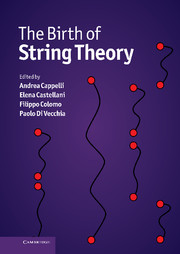Book contents
- Frontmatter
- Contents
- List of contributors
- Photographs of contributors
- Preface
- Abbreviations and acronyms
- Part I Overview
- EARLY STRING THEORY
- Part II The prehistory: the analytic S-matrix
- Part III The Dual Resonance Model
- Part IV The string
- 19 Introduction to Part IV
- 20 From dual models to relativistic strings
- 21 The first string theory: personal recollections
- 22 The string picture of the Veneziano model
- 23 From the S-matrix to string theory
- 24 The analogue model for string amplitudes
- 25 Factorization in dual models and functional integration in string theory
- 26 The hadronic origins of string theory
- TOWARDS MODERN STRING THEORY
- Part V Beyond the bosonic string
- Part VI The superstring
- Part VII Preparing the string renaissance
- Appendix A Theoretical tools of the Sixties
- Appendix B The Veneziano amplitude
- Appendix C From the string action to the Dual Resonance Model
- Appendix D World-sheet and target-space supersymmetry
- Appendix E The field theory limit
- Index
21 - The first string theory: personal recollections
from Part IV - The string
Published online by Cambridge University Press: 05 May 2012
- Frontmatter
- Contents
- List of contributors
- Photographs of contributors
- Preface
- Abbreviations and acronyms
- Part I Overview
- EARLY STRING THEORY
- Part II The prehistory: the analytic S-matrix
- Part III The Dual Resonance Model
- Part IV The string
- 19 Introduction to Part IV
- 20 From dual models to relativistic strings
- 21 The first string theory: personal recollections
- 22 The string picture of the Veneziano model
- 23 From the S-matrix to string theory
- 24 The analogue model for string amplitudes
- 25 Factorization in dual models and functional integration in string theory
- 26 The hadronic origins of string theory
- TOWARDS MODERN STRING THEORY
- Part V Beyond the bosonic string
- Part VI The superstring
- Part VII Preparing the string renaissance
- Appendix A Theoretical tools of the Sixties
- Appendix B The Veneziano amplitude
- Appendix C From the string action to the Dual Resonance Model
- Appendix D World-sheet and target-space supersymmetry
- Appendix E The field theory limit
- Index
Summary
Here is how I remember it. Supposedly I was a particle physicist: indeed I had spent three years as a graduate student in Cornell (1962–1965) and a year as a postdoc in Berkeley (1965–1966), learning about S-matrix theory, and hating every minute of it. The general opinion among leaders of the field was that hadronic length and time scales were so small that in principle it made no sense to probe into the guts of a hadronic process – the particles and the reactions were unopenable black boxes. Quantum field theory was out; Unitarity and Analyticity were in. Personally, I so disliked that idea that when I got my first academic job I spent most of my time with my close friend, Yakir Aharonov, on the foundations of quantum mechanics and relativity.
By 1967 I was convinced that the S-matrix black-box view was wrong-headed. I had spent a lot of time formulating relativistic quantum theory in what was then called the infinite-momentum frame (IMF), now called the light-cone frame. The idea that appealed to me was that by boosting a system to very large momentum you could slow down its internal motions. By stationing a sequence of detectors along the direction of the boost, one could imagine probing an interacting system of hadrons as it evolved. I wrote a lot of papers showing among other things that physics in the IMF had a Galilean symmetry so that the ordinary rules of nonrelativistic quantum mechanics must apply.
- Type
- Chapter
- Information
- The Birth of String Theory , pp. 262 - 265Publisher: Cambridge University PressPrint publication year: 2012
- 2
- Cited by



